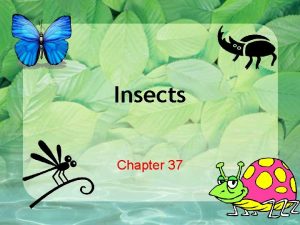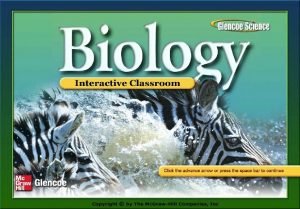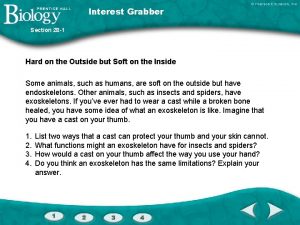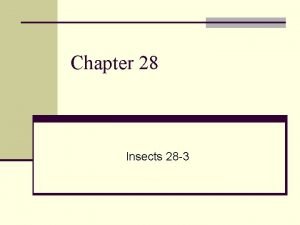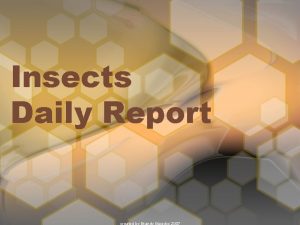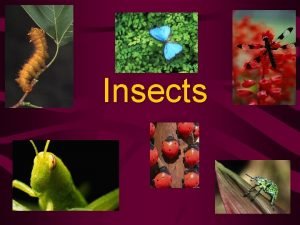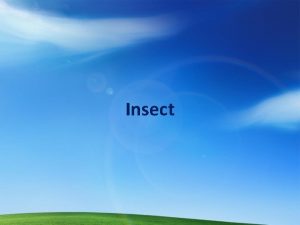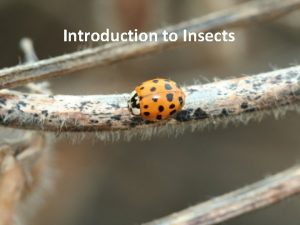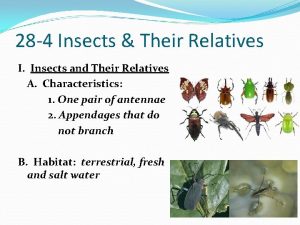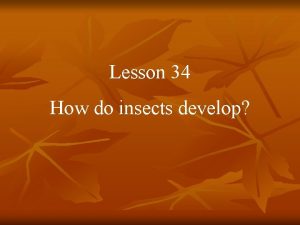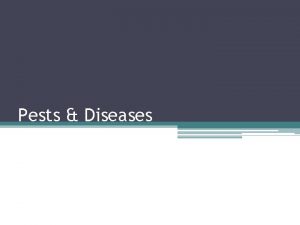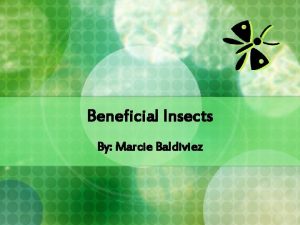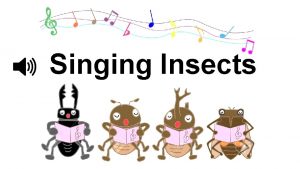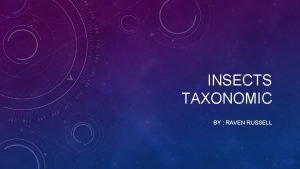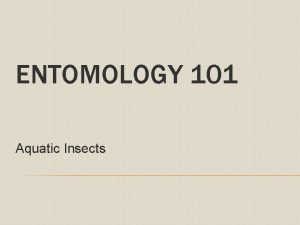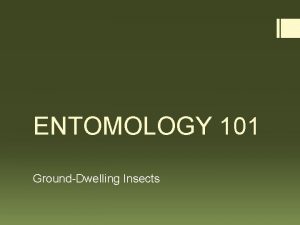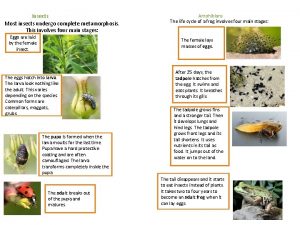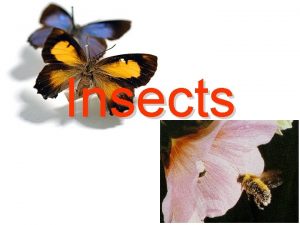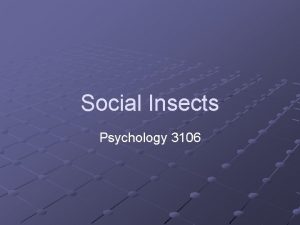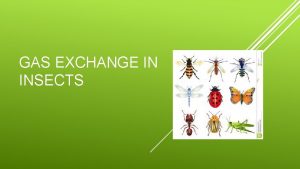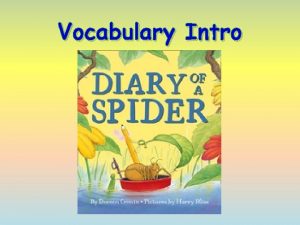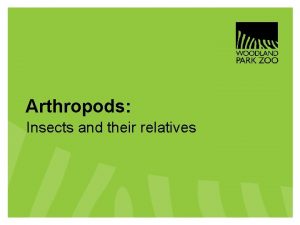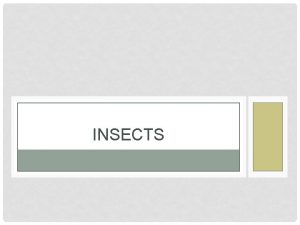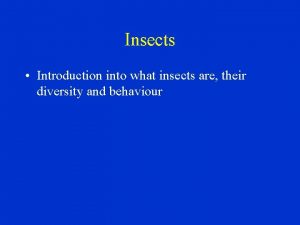Insects Chapter 37 The Insect World Section 37



































- Slides: 35

Insects Chapter 37

The Insect World Section 37. 1

Characteristics of Insects Three tagmata: 1. Head: mandibles to chew, pair of antennae for sensory 2. Thorax: 3 pairs of jointed legs, most have 1 or 2 pairs of wings 3. Abdomen: 9 -11 segments

Head Thorax Abdomen

Exoskeleton with… Antennae Examples: Leg Examples:

Appendage examples:

Two types of mouthparts:

Entomology: • The study of insects – & other terrestrial arthropods • Person = entomologist – Classify insects into 25 orders based up: • Mouthparts • Number of wings • Type of development

Classification of Insects • Subphylum: Hexapoda • Class: Insecta • Common Orders: – – – – – Hemiptera Homoptera Isoptera Odonata Orthoptera Coleoptera Diptera Hymenoptera Lepidoptera Table on page 743

Success of Insects • Insects live everywhere (except deep ocean) • 1 million species (more than 3 x all other animals!) – 10 million might exist • Why so many? – Ability to fly • Escape & dispersal – Small – Short life spans • Quick adaptations

Insects and People • Competition for food • Spread diseases – Plague, typhoid fever, malaria • Consume clothing & carpet • Crop pollination • Make commercial products – Wax, silk, honey • Recycle nutrients VIDEO

Insect Development • Hatchling must go through several molts to reach adulthood (sexual maturity) • Metamorphosis: major developmental changes from larvae to adult • Two forms: incomplete & complete

Incomplete Metamorphosis • Nymph: immature form of insect that looks like adult • Only the adult can fly and is sexually mature

Complete Metamorphosis • Two stages of development that look drastically different • Pupa: changing from larvae to adult • Cocoon: protective covering of pupa • Chrysalis: butterfly pupa protection

Insect Defense • Passive defense examples: – Camouflage – Look like plants • Aggressive defense examples: – Venomous stingers – Harmful chemicals • Warning coloration: color pattern to warn of poison

Mimicry • Mullerian mimicry: poisonous species mimics the coloration of another poisonous species – Bees & wasps • Batesian mimicry: harmless species mimics the coloration of a poisonous species – Monarch & viceroy butterflies

Grasshoppers Subphylum Hexapoda

External Structures: • Head = mouthparts, antennae, simple & compound eyes • Thorax = 3 parts: – Prothorax = 1 st pair walking legs – Mesothorax = 2 nd pair walking legs & forewings (protective) – Metathorax = 3 rd pair legs (jumping) & hindwings (flying)

• Abdomen = upper & lower plates connected by flexible exoskeleton – Covered by waxy cuticle (prevents desiccation)

Feeding • Chewing mouthparts (feed on plants) – Labrum: functions like upper lip – Labium: functions like lower lip – Mandible: tears food – Maxilla: helps hold & cut food Video

Digestive Tract • Mouth saliva (from salivary glands) esophagus crop (storage) gizzard midgut/stomach (bathed in enzymes from gastic ceca) nutrients absorbed in hindgut/intestine anus

Circulation, Respiration, & Excretion • Circulatory system: – Open – Aorta (large, dorsal vessel) – Heart (pumping organ) • Respiratory system: – Tracheae (site of air diffusion inside body) – Spiracles (openings to allow air in/out) • Excretory system: – Malpighian tubules: return most water back to hemolymph, rest leaves body via feces

Neural Control • CNS = brain, ventral nerve cord, & ganglia at each segment • Antennae – touch & smell • 3 simple eyes – intensity of light • 2 compound eyes – sight • Tympanum – sound & communication • Sensory hairs - touch

Reproduction • Separate sexes (male & female) • Sexual Reproduction: 1. male deposits sperm into female seminal receptacles 2. Eggs released from ovaries 3. Internal fertilization 4. Ovipositor: digs a hole in soil to lay eggs


Insect Behavior Section 37. 2

Communication • Chemical communication via pheromones – Chemical released that affects behavior or development of other members of same species video • Uses of pheromones: – Attract mates – Identify hives – Food trails

Communication Con’t… • Sound communication via chirping, buzzing, etc. (crickets, mosquitoes) – Attract females – Protect territories • Sight communication via flashes of light (fireflies) – Find mates

Behavior in Honeybees • Social insects: insects that live in colonies with division of labor • Innate behaviors: genetically determined – Not taught or learned • Three types of honeybees: 1. Worker 2. Drone 3. Queen

Worker Bees • Sterile females • First adult week: feed honey & pollen to queen, drones, & larvae – Royal jelly • Next two weeks: secrete wax (build & repair honeycomb), remove wastes, guard hive, circulate air in hive

Continued… • Last weeks of life: collect nectar & pollen • Adaptations: – Barbed stingers for protection of hive – Mouthparts for lapping nectar – Legs with pollen packers, baskets, & pollen combs

Drones • Males developed from unfertilized eggs – Parthenogenesis • Can travel from hive to hive • Sole function: deliver sperm to queen – succeed in mating = death – penis and associated abdominal tissues are ripped from the body at intercourse

Queen Bee • Continuous diet of royal jelly as larvae = queen bee • Secretes pheromone “queen factor” that prevents other females developing into queens • Sole role: reproduction – Mates only once – Sperm remains inside her for 5+ years – Lays millions of eggs per year! Video

The Dances of the Bees • Dancing performed by scout worker bees • Round dance: told workers that food was nearby but not exact location • Waggle dance: told workers that food was far away and told location

Altruistic Behavior • Definition: aiding other individuals at one’s own risk or expense • Kin selection: increasing the propagation of one’s own genes by helping closely related individuals reproduce • Example: worker bee stinging = death Video
 Characteristics of insects
Characteristics of insects Arthropods characteristics
Arthropods characteristics Price of sport sandals drops drastically
Price of sport sandals drops drastically Section 28-4 echinoderms answer key
Section 28-4 echinoderms answer key Section 28-3 insects
Section 28-3 insects Ap world history chapter 25 africa and the atlantic world
Ap world history chapter 25 africa and the atlantic world Chapter 17 section 3 world history
Chapter 17 section 3 world history Chapter 30 section 2 world history
Chapter 30 section 2 world history Chapter 15 section 2 world history
Chapter 15 section 2 world history Chapter 9 section 4 reforming the industrial world
Chapter 9 section 4 reforming the industrial world Chapter 25 section 4 reforming the industrial world
Chapter 25 section 4 reforming the industrial world Chapter 24 world war looms section 1 answers
Chapter 24 world war looms section 1 answers World history chapter 15 section 3
World history chapter 15 section 3 Chapter 16 section 1 dictators threaten world peace
Chapter 16 section 1 dictators threaten world peace Chapter 9 section 4 reforming the industrial world
Chapter 9 section 4 reforming the industrial world World war looms chapter 24
World war looms chapter 24 World geography chapter 16 section 1
World geography chapter 16 section 1 Chapter 20 section 1 world history
Chapter 20 section 1 world history Chapter 8 section 2 world history
Chapter 8 section 2 world history Chapter 23 section 3 world history
Chapter 23 section 3 world history Chapter 8 section 1 world history
Chapter 8 section 1 world history Chapter 16 section 1 world history
Chapter 16 section 1 world history Chapter 24 section 1 dictators threaten world peace
Chapter 24 section 1 dictators threaten world peace Chapter 16 section 1 dictators threaten world peace
Chapter 16 section 1 dictators threaten world peace Chapter 11 section 1 the civil war begins
Chapter 11 section 1 the civil war begins World war 1 begins chapter 11 section 1
World war 1 begins chapter 11 section 1 Chapter 13 section 3 war affects the world
Chapter 13 section 3 war affects the world Chapter 14 section 1 world history
Chapter 14 section 1 world history World geography chapter 8 section 1
World geography chapter 8 section 1 World geography chapter 6 section 1
World geography chapter 6 section 1 Chapter 4 section 4 world history
Chapter 4 section 4 world history Absolute monarchy in russia
Absolute monarchy in russia World history chapter 13 section 1
World history chapter 13 section 1 World war 1 begins chapter 19 section 1
World war 1 begins chapter 19 section 1 World history chapter 10 section 1
World history chapter 10 section 1 Chapter 9 section 4 reforming the industrial world
Chapter 9 section 4 reforming the industrial world
